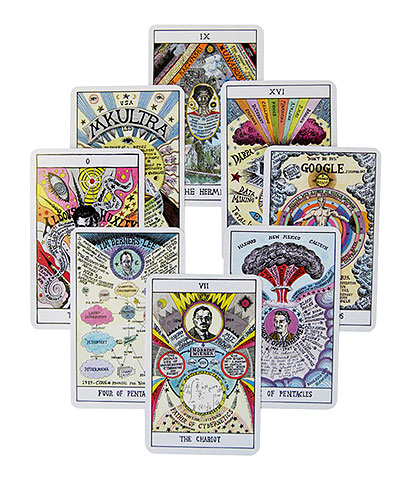|
|
||
|
Pattern recognition is a fundamental human talent. The ability to derive threads of meaning hidden among disordered information underpins our intelligence. It unites science and art. But it can lead us into madness. This might be via pattern recognition’s paranoid brother, pareidolia: seeing a design where none exists, discerning a vast and elegant structure of connections that exists only in ourown eye, assembling black clockwork from pure air. Or it might be via the Casaubon delusion: a desperate quest to completely catalogue and taxonomise a system, a quest that leads the victim into proliferating subcategories and unending digressive appendices. Suzanne Treister’s art operates at this fraying fringe of pattern recognition, where it degenerates into noise and hypnotic distortion. Her 2004-2008 project NATO was to paint watercolours of every type of object in the Western military alliance’s codification system – which is to say, every kind of object in the world, a completely Casaubonian enterprise. Her work subsists in the rich, dark mulch of conspiracy theories, unofficial history and the occult – again, a line of enquiry that promises a grand unified system for understanding the world and its hidden patterns, but which yields infinite interconnecting rabbit holes.
In Hexen 2.0, Treister has distilled the dizzying, upsetting sense of paranoid possibility that accompanies conspiracy theories and alternate histories into something like a pure form. Hexen 2.0 is a modern tarot, a deck of cards used for divination, the telling of fortunes. Each of the figures or values in the tarot deck – the Hanged Man, the seven of Chalices and such – is replaced by a person, object or concept from the history of the military-industrial complex, information technology, cybernetics, psychology, or the counterculture. Ken Kesey and the United States Cyber Command rub shoulders with drones and LSD. Treister’s illustrations on the cards are an eerie delight: symbol-dense, fact-strewn, dreamlike tableaux, at once highly precise and slightly off the rails, similar to the text-art of William Blake (five of Wands). The best-known card in the tarot deck is certainly Death, and on that card in Treister’s deck is John von Neuman – mathematician, key player in the Manhattan Project and military-industrial-computing giant.(If human beings are ever supplanted by self-replicating machines, Von Neuman’s name will surely come up at the post mortem.) The Hermit is, naturally enough, Theodore Kaczynski, better known as the Unabomber, a mathematician who ran a bombing campaign from a cabin in Montana in the 1990s. Kaczynski’s anti-technology, anti-government “manifesto” also features as the Knight of Wands, a suit that contains a number of more humane figures including William Gibson, Alan Turing and Hannah Arendt. King of Wands is the wizardly Nikola Tesla, an appropriate choice given his centrality to any self-respecting alternative history of modernity. The Swords suit is very threatening indeed: two of Swords is one-world state and eugenics advocate HG Wells; three is MKULTRA, the CIA’s mind-control programme; four is the World Federation for Mental Health; five is our friend Google. A central connecting node is the Macy conferences of the 1940s and 1950s, which tried to establish a general science for the working of the human mind. From that point, a web of influence is spun from psyops and brainwashing to the internet, surveillance and electronic warfare. And there’s the ghost of an alternative path, from the Levellers to anarchist cybernetic utopians and Soviet ternary computers. Or not. Hexen is available as a book and deck of cards – the book gives some additional details and works, but it’s the deck of cards that really shows the genius of the project. Take the deck, shuffle the cards and deal out a few, let the imagination sketch in the connections and voila: a new covert model for the modern world. Shuffle and deal again, and you get another. The connections and lines of influence flicker and recombine, and so does your view of the way things are. Dangerous precedents and trajectories for the future weave in and out of the confusing scenery. History becomes vague and plastic. It’s a beautiful, troubling project, and a hugely desirable artefact. For a 40% discount on Hexen 2.0, send an email to [email protected] with the title “Icon offer”, putting your delivery address in the body of the email. |
Image Jon Wiggins
Words Will Wiles |
|
|
||


















